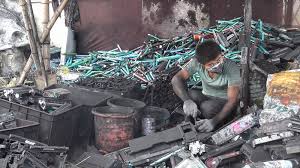Reducing Landfill Waste: The Environmental Importance of Refilling Printer Cartridges
In today's digital world, the use of printers remains a
constant necessity for both personal and professional tasks. However, the
environmental impact of discarded printer cartridges is a growing concern.
Globally, millions of cartridges are thrown into landfills each year, where
they can take up to 1,000 years to decompose. This alarming statistic
underscores the urgent need for sustainable practices such as cartridge refilling.
This knowledge paper explores the environmental significance of refilling
printer cartridges and its benefits for a greener planet.
The Global Impact of Printer Cartridges in Landfills
According to various environmental studies, over 375 million
empty ink and toner cartridges are discarded annually in the United States
alone. When extended to a global scale, this number reaches a staggering
figure, contributing significantly to landfill waste. Here are some key global
figures and their implications:
1. Millions of
Cartridges Discarded: Annually, it is estimated that around 1.3 billion
inkjet and toner cartridges are used worldwide. A large portion of these
cartridges ends up in landfills.
2. Longevity in
Landfills: Printer cartridges are made from a combination of plastics,
metals, and other materials that can take up to 1,000 years to decompose. This
long decomposition period means that cartridges discarded today will persist in
the environment for many generations.
3. Environmental
Pollution: The materials in printer cartridges, such as plastic and
residual toner or ink, can leach harmful chemicals into the soil and
groundwater, contributing to environmental pollution and potential health
risks.
The Importance of Refilling Cartridges
Given the significant environmental impact of discarded
cartridges, refilling offers a sustainable and eco-friendly solution. Here are
the key benefits of refilling printer cartridges:
1. Waste Reduction:
Refilling cartridges helps reduce the volume of waste that
ends up in landfills. By reusing cartridges multiple times, the need for new
cartridges diminishes, thereby decreasing the overall waste generated.
2. Conservation of
Resources:
The production of new cartridges requires raw materials such
as plastic, aluminum, and oil. Refilling conserves these resources by reducing
the demand for new cartridge manufacturing, which, in turn, conserves energy
and raw materials.
3. Lower Carbon
Footprint:
Manufacturing and transporting new cartridges contribute to
carbon emissions. Refilling cartridges locally reduces the carbon footprint
associated with production and logistics, promoting a more sustainable printing
ecosystem.
4. Cost Savings:
Refilling cartridges is often more cost-effective than
purchasing new ones. This cost efficiency benefits consumers and businesses
alike, making sustainable practices economically attractive.
5. Promoting a
Circular Economy:
Refilling supports the principles of a circular economy,
where products and materials are kept in use for as long as possible. This
approach minimizes waste and maximizes resource efficiency, fostering
sustainable development.
How Refilling Helps the Environment
1. Reducing Plastic
Waste:
Printer cartridges are primarily composed of plastic, which
is a major contributor to environmental pollution. By refilling cartridges, the
amount of plastic waste is significantly reduced, mitigating its impact on
ecosystems and wildlife.
2. Preventing
Pollution:
Refilled cartridges reduce the risk of chemical leaching
from discarded cartridges. Properly managed refilling processes ensure that
residual toner and ink are handled safely, preventing contamination of soil and
water.
3. Encouraging
Responsible Consumption:
Refilling cartridges encourages consumers and businesses to
adopt more responsible consumption habits. It raises awareness about the
environmental impact of printing and promotes more sustainable choices.
4. Supporting Green
Initiatives:
Many organizations and businesses are increasingly prioritizing sustainability in their operations. Refilling cartridges aligns with green initiatives and corporate social responsibility goals, enhancing an organization's environmental credentials.
The global impact of discarded printer cartridges in landfills is a pressing environmental issue that requires immediate attention. With millions of cartridges taking up to 1,000 years to decompose, the need for sustainable solutions like cartridge refilling has never been more critical. Refilling cartridges offers numerous benefits, including waste reduction, resource conservation, lower carbon emissions, cost savings, and support for a circular economy.


